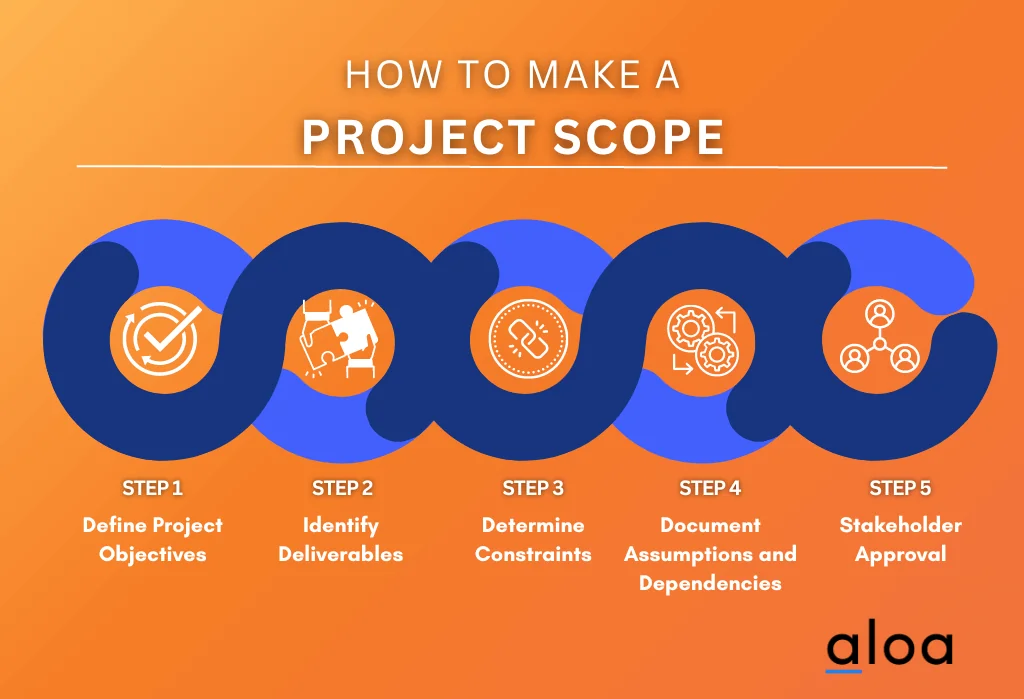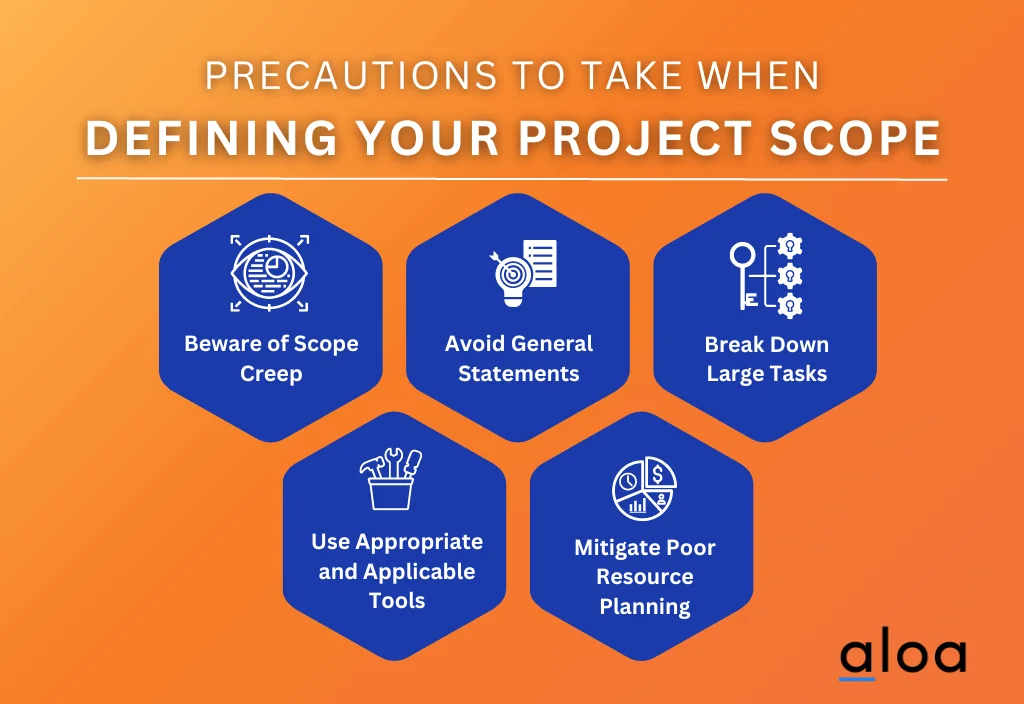Project scope management is a crucial aspect of project management that defines the boundaries and objectives of a project. It outlines the deliverables, tasks, and goals that must be accomplished within a specific timeframe and budget. Without a well-defined project scope, projects can suffer from scope creep, leading to cost overruns, missed deadlines, and decreased overall project success.
Effective project management is a key component of Aloa’s process, the backbone of a successful software development project. Aloa continuously works to improve the transparency and accountability of every project with efficient project management. While Aloa leverages its internal tool, Aloa Manage, to navigate each project, there are many tools out there to facilitate your project management experience.
In this blog, we will delve into project scope, explore how to use and create project scopes effectively, provide further insights, discuss the benefits of project scope for businesses and startups, and conclude with key takeaways to enhance your project management practices.
Let’s get started!
What is a Project Scope?
A project scope is a comprehensive outline delineating a project's tasks, goals, deliverables, and limitations. It can be considered the project's blueprint, establishing boundaries that keep the project from drifting off track. This determines what needs to be accomplished and the work that must be done to deliver the project. This is work you can either do yourself or you can do through project management staffing services.
The importance of a well-defined project scope cannot be overstated. It is instrumental in ensuring project success as it sets clear expectations for everyone involved - from team members to project managers up to the stakeholders. Additionally, a meticulously designed project scope aids in resource management, ensuring resources are effectively allocated and used, thereby preventing wastage and promoting efficiency.
The key elements that comprise the project scope are deliverables, objectives, milestones, and constraints. Deliverables are the tangible results or products expected from the project, objectives outline the project's goals, milestones mark significant stages in the project timeline (for instance, project milestones examples include completing the design phase, launching a prototype, or finishing user testing), and constraints represent limitations that could hamper project progression.
How To Make A Project Scope
Creating a project scope is an essential process that can drastically impact the outcome of your project. It sets a solid foundation for all project-related decisions and actions. Here's how you can effectively create a project scope:

Step 1: Define Project Objectives
The first and foremost step is clearly defining the project's objectives. The goals should be SMART - Specific, Measurable, Achievable, Relevant, and Time-bound.
Let's consider the following project scope for a small business accounting application as an example:
- Specific: Design, develop, and implement a user-friendly small business accounting application with features for invoicing, expense tracking, and financial reporting. In fact, you can also try and MS Excel Invoice Template for creating and sending invoices. Using a template will ensure professionalism and can save time.
- Measurable: Increase the daily active users by 15% within the first three months post-launch.
- Achievable: UI/UX designers, with their vast experience in accounting software, will utilize Agile methodology to develop and implement the application. They have also allocated a reasonable budget and timeline to the project.
- Relevant: The project aligns with our organization's broader goals of providing efficient, affordable digital solutions to small businesses and expanding our product line in business software applications.
- Time-bound: The accounting application should be ready for launch within nine months from the commencement of the project.
Each objective should provide value to the project, linking it to the broader organizational goals. Clearly stating the project objectives at the onset gives direction and purpose to the project, ensuring all members are working towards a unified end.
Step 2: Identify Deliverables
The next step involves identifying the deliverables of the project. These are the tangible outputs or results that will be produced after the project. These could be a new product, a refined process, or any measurable output that delivers value to the end user or stakeholder. Specifying the deliverables upfront ensures clarity later in the project about what the project will produce. After the scope gets approved, the project manager will outline the tasks and create a roadmap.
Step 3: Determine Constraints
Every project has its limitations or constraints. These could be budgetary constraints, time constraints, legal constraints, or any other restrictions that could impact the project. By identifying these constraints in advance, the project team can plan strategies to mitigate their impact.
Set Timelines
Establishing realistic timelines for each task and the overall project is crucial for maintaining momentum and ensuring the project stays on track. Timelines provide a visual representation of the project’s schedule, aiding team members in understanding when their tasks need to be completed. You can leverage agile project management strategies to work through timelines while balancing priorities efficiently.
Identify Resources
This involves determining the resources required for the project, such as personnel, equipment, and materials. Identifying resources upfront ensures that everything necessary for project execution is available when needed, avoiding delays and inefficiencies.
This involves identifying all the stakeholders related to the project, understanding their expectations and level of influence, and managing their engagement throughout the project. Effective stakeholder management can help avoid conflicts, ensure smooth communication, and align everyone's expectations, thus driving the project toward its objectives.
Step 4: Document Assumptions and Dependencies
Regarding project planning, teams often make assumptions about the dependencies between identified tasks. Taking the time to document these assumptions and dependencies makes it easier to anticipate potential issues. Overall, it will aid in formulating thorough contingency plans should any risk arise during implementation.
Step 5: Review and Get Stakeholder Approval
The final step is to share the project scope document with all relevant stakeholders and get their approval. This is a critical step as it ensures everyone has the same understanding of the project scope and its elements. This alignment leads to better collaboration and reduces the likelihood of scope creep, which can derail a project.
Creating a well-defined project scope document using these steps can help set your project up for success. It ensures all team members and stakeholders understand the project's direction, increases its chances of staying within defined boundaries, and significantly contributes to successful project completion.
Similarities and Differences: Project Scope and Other Project Management Concepts
In project management, several concepts work together to ensure the successful execution of a project. Among these are project scope, charter, and plan. Recognizing the similarities and differences between these elements can clarify their roles and how they interact within the broader project management framework.
Project Scope vs. Project Plan
A project plan, or project roadmap, is a document that details the process of achieving these deliverables, including resources, timelines, and roles and responsibilities. It is an extension of the project scope and provides a more detailed roadmap for the project. The project plan is typically created after the project scope has been defined and approved.
For startups, project plans are beneficial for breaking down and sorting project tasks into actionable steps. While the project scope outlines what needs to be done, the project plan helps you think through how to execute it.
Project Scope vs. Project Charter
A project charter is a document that officially authorizes a project, containing a high-level overview, including its purpose, stakeholders, and primary deliverables. It often has the project scope but includes additional information like the project sponsor, budget, and high-level risks.
For most startups, project charters are not necessary or practical due to the extensive and rigid nature of the document. Projects are prioritized and deprioritized daily in the startup world, so writing a project charter would probably not be a good use of your limited resources. Startups might consider writing a project charter if the team needs to convince external stakeholders (like investors) to move in a drastically different direction, but that is very uncommon. An up-to-date understanding of the project scope and plan is enough to align a team.
Understanding these similarities and differences can enable project managers to better utilize these concepts for successful project planning and execution. While each of these elements is distinct, they are all crucial for providing clarity, direction, and structure to a project, ensuring that it is completed on time, within budget, and according to specified quality standards. By leveraging each concept appropriately, project managers can effectively guide their projects to successful completion.
Precautions To Take When Defining Your Project Scope
Creating a comprehensive project scope is critical in the project management process. However, it has its potential pitfalls. Here are some precautions to consider when defining your project scope.

Beware of Scope Creep
Scope creep is a project management term that refers to uncontrolled changes or continuous growth in a project's scope. Scope creep typically happens when stakeholders want the team to perform additional work outside the scope agreement. It can lead to cost overruns, delays, and even project failure.
To mitigate the risk of scope creep, adopt a proactive approach. Begin with a clearly defined project scope, and ensure it is communicated and understood by all stakeholders. Also, implement a process for handling any requested scope changes, including evaluation, decision-making, and communication protocols.
Avoid Overly General Statements
When defining project scope, one common mistake is using overly general or ambiguous statements. This lack of clarity can lead to misinterpretation and misunderstanding, causing deviations from the intended scope.
To avoid this, ensure that your project scope is detailed and specific. It should clearly define the project's objectives, deliverables, tasks, and constraints. Every aspect of the project should be described in a way that leaves no room for misinterpretation.
Mitigate Poor Resource Planning
Poor resource planning is a pitfall that can lead to wasted resources, budget overruns, and project delays. It happens when the necessary resources for the project, such as personnel, equipment, and materials, need to be adequately identified or allocated.
To prevent this, carefully identify all the resources needed for your project when defining the project scope. This should include human resources, equipment, materials, and anything else needed to complete the project. Also, consider any potential limitations or constraints, such as budgetary constraints or resource availability.
Breakdown Tasks Into Small Chunks
In project management, especially within Agile methodologies, projects are broken down into smaller, more manageable tasks, often called 'sprints.' Neglecting to do so can make the project seem overwhelming and lead to an oversight in task planning and execution.
To ensure your project is manageable and to enhance efficiency, break down large tasks into smaller chunks. Each task should have a defined start and end, clear objectives, and designated resources.
Use Appropriate and Applicable Tools
There is a multitude of project management tools available today, each with its unique set of features and benefits. However, not all tools will fit the needs of your project. Using a tool that doesn't align with your project's objectives can lead to inefficiencies and complications.
When choosing a project management tool, consider your project's unique needs and the tool's features and capabilities. Ensure the tool can support your project scope and help plan, execute, monitor, and control the project effectively.
When defining your project scope, taking these precautions can set a strong foundation for successful project execution. A well-planned project scope can help guide your project to its successful completion, ensuring it is completed on time, within budget, and meets its objectives.
Benefits of Project Scope
Defining the project scope is a crucial aspect of project management, laying the groundwork for success. Here are some significant benefits of investing time and effort in defining a comprehensive project scope:
.webp)
Provides Clarity and Direction
The scope clearly describes what the project aims to achieve, including its objectives, deliverables, and limitations. This clarity prevents confusion and misinterpretation, offering a clear direction for all stakeholders involved. Everyone should know the tasks that need to be accomplished and the constraints they need to work within.
Establishes Boundaries
The project scope delineates the boundaries of a project, ensuring that it doesn’t deviate or drift off course. It clearly defines what part of the project (in-scope) is and is not (out of scope), ensuring that resources and efforts are focused on the right areas. This can prevent the project team from spending time and resources on activities that aren't crucial to the project's success.
Enhances Communication and Reduces Misunderstanding
Clearly defining the project scope makes it easier for the project team and stakeholders to communicate effectively. Stakeholders clearly understand the project’s goals, objectives, deliverables, and limitations, reducing the chance of misunderstandings and disagreements that can delay a project.
Facilitates Project Planning and Execution
A well-defined project scope makes it easier to plan and execute the project. It aids in task identification, sequencing, duration estimation, and resource allocation, smoother the project planning process. Also, during execution, the project team can refer to the scope to ensure they are on track.
Manages Stakeholder Expectations
Project scope manages stakeholder expectations by clearly outlining what the project will deliver. When stakeholders understand the project's boundaries and goals, they're more likely to have realistic expectations, leading to higher satisfaction.
Helps Constrain Scope Creep
One of the key benefits of defining project scope is constraining scope creep, the uncontrolled changes or continuous growth in a project’s scope. With a defined project scope, any requested changes can be evaluated against the original plan, and a formal process can be followed to accept or reject the changes, keeping the project under control.
Aids in Risk Management
A defined project scope helps identify potential risks and plan for risk mitigation. With a clear understanding of the project's objectives, deliverables, tasks, and limitations, the project team can anticipate potential issues and implement measures to minimize their impact.
Ensures Efficient Resource Utilization
By specifying the tasks and deliverables of a project, the project scope aids in resource planning and allocation. This ensures that resources, such as personnel, materials, and equipment, are efficiently utilized, reducing waste and increasing productivity.
Key Takeaways
Project scope management is a fundamental pillar of successful project execution. It provides clarity, direction, and structure, defining what will be achieved and outlining the path. Understanding and addressing potential pitfalls such as scope creep, generalization, poor resource planning, task segmentation, and tool selection are vital to ensure your project scope is robust and effective.
In turn, the benefits of a well-defined project scope are countless, including enhanced communication, efficient resource utilization, effective risk management, and prevention of scope creep. It's an investment that pays dividends in successful project delivery.
However, crafting a comprehensive project scope can be a challenging process. It requires skill, experience, and a deep understanding of project management principles. If you're seeking professional guidance or valuable resources to boost your project management skills, don't hesitate to contact Aloa at [email protected]. With our expertise, you can ensure your project scope is well-defined, setting the stage for successful execution.

